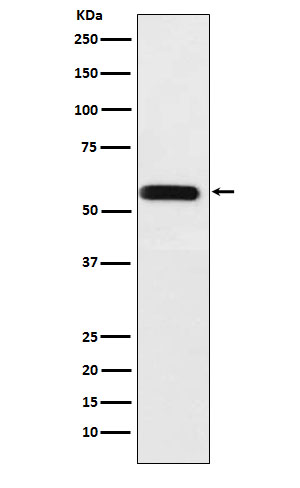ANGPTL3 Rabbit mAb [pJTC]Cat NO.: A35132
Western blot(SDS PAGE) analysis of extracts from A375 cell lysate.Using ANGPTL3 Rabbit mAb [pJTC]at dilution of 1:1000 incubated at 4℃ over night.
Product information
Protein names :ANG5; Angiopoietin 5; Angiopoietin like 3; ANGPT5; ANGPTL3; ANL3; FHBL2;
UniProtID :Q9Y5C1
MASS(da) :53,637
MW(kDa) :54kDa
Form :Liquid
Purification :Affinity-chromatography
Host :Rabbit
Isotype : IgG
sensitivity :Endogenous
Reactivity :Human,Mouse,Rat
- ApplicationDilution
- 免疫印迹(WB)1:1000-2000
- 免疫荧光(ICC/IF)1:100
- The optimal dilutions should be determined by the end user
Specificity :Antibody is produced by immunizing animals with A synthesized peptide derived from human ANGPTL3
Storage :Antibody store in 10 mM PBS, 0.5mg/ml BSA, 50% glycerol. Shipped at 4°C. Store at-20°C or -80°C. Products are valid for one natural year of receipt.Avoid repeated freeze / thaw cycles.
WB Positive detected :A375 cell lysate.
Function : Acts in part as a hepatokine that is involved in regulation of lipid and glucose metabolism (PubMed:11788823, PubMed:12909640, PubMed:23661675, PubMed:25495645). Proposed to play a role in the trafficking of energy substrates to either storage or oxidative tissues in response to food intake (By similarity). Has a stimulatory effect on plasma triglycerides (TG), which is achieved by suppressing plasma TG clearance via inhibition of LPL activity. The inhibition of LPL activity appears to be an indirect mechanism involving recruitment of proprotein convertases PCSK6 and FURIN to LPL leading to cleavage and dissociation of LPL from the cell surface,the function does not require ANGPTL3 proteolytic cleavage but seems to be mediated by the N-terminal domain, and is not inhibited by GPIHBP1 (PubMed:12097324, PubMed:19318355, PubMed:20581395). Can inhibit endothelial lipase, causing increased plasma levels of high density lipoprotein (HDL) cholesterol and phospholipids (PubMed:17110602, PubMed:19028676). Can bind to adipocytes to activate lipolysis, releasing free fatty acids and glycerol (PubMed:12565906). Suppresses LPL specifically in oxidative tissues which is required to route very low density lipoprotein (VLDL)-TG to white adipose tissue (WAT) for storage in response to food,the function may involve cooperation with circulating, liver-derived ANGPTL8 and ANGPTL4 expression in WAT (By similarity). Contributes to lower plasma levels of low density lipoprotein (LDL)-cholesterol by a mechanism that is independent of the canonical pathway implicating APOE and LDLR. May stimulate hypothalamic LPL activity (By similarity).., [ANGPTL3(17-221)]: In vitro inhibits LPL activity,not effective on GPIHBP1-stabilized LPL.., Involved in angiogenesis. Binds to endothelial cells via integrin alpha-V/beta-3 (ITGAV:ITGB3), activates FAK, MAPK and Akt signaling pathways and induces cell adhesion and cell migration (PubMed:11877390). Secreted from podocytes, may modulate properties of glomerular endothelial cells involving integrin alpha-V/beta-3 and Akt signaling (PubMed:18535744). May increase the motility of podocytes. May induce actin filament rearrangements in podocytes implicating integrin alpha-V/beta-3 and Rac1 activation. Binds to hematopoietic stem cells (HSC) and is involved in the regulation of HSC activity probably implicating down-regulation of IKZF1/IKAROS (By similarity)..
Tissue specificity :Expressed principally in liver. Weakly expressed in kidney. Binds to adipocytes. Increased expression and colocalization with activated ITGB3 in glomeruli of patients with nephrotic syndrome showing effaced podocyte foot processes (at protein level)..
Subcellular locationi :Secreted. Cell projection, lamellipodium.
IMPORTANT: For western blots, incubate membrane with diluted primary antibody in 1% w/v BSA, 1X TBST at 4°C overnight.


